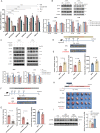Endogenous Coriobacteriaceae enriched by a high-fat diet promotes colorectal tumorigenesis through the CPT1A-ERK axis
- PMID: 38245554
- PMCID: PMC10799938
- DOI: 10.1038/s41522-023-00472-7
Endogenous Coriobacteriaceae enriched by a high-fat diet promotes colorectal tumorigenesis through the CPT1A-ERK axis
Abstract
A high-fat diet (HFD) may be linked to an increased colorectal cancer (CRC) risk. Stem cell proliferation and adipokine release under inflammatory and obese conditions are the main factors regulating CRC progression. Furthermore, alterations in intestinal flora have been linked to tumorigenesis and tumour progression. However, whether a HFD can promote CRC occurrence by altering intestinal flora remains unclear. The objective of this study was to identify bacterial strains enriched by a HFD and investigate the association and mechanism by which a HFD and bacterial enrichment promote CRC occurrence and development. In this study, the intestinal microbiota of mice was assessed using 16S rRNA and metagenomic sequencing. Serum metabolites of HFD-fed mice were assessed using tandem liquid chromatography-mass spectrometry. CRC cell lines and organoids were co-cultured with Coriobacteriaceae to evaluate the effect of these bacteria on the CPT1A-ERK signalling pathway. We found that Coriobacteriaceae were enriched in the colons of HFD-fed mice. An endogenous Coriobacteriaceae strain, designated as Cori.ST1911, was successfully isolated and cultured from the stools of HFD-fed mice, and the tumorigenic potential of Cori.ST1911 in CRC was validated in several CRC mouse models. Furthermore, Cori.ST1911 increased acylcarnitine levels by activating CPT1A, demonstrating the involvement of the CPT1A-ERK axis. We also found that the endogenous Lactobacillus strain La.mu730 can interfere with Cori.ST1911 colonisation and restore gut barrier function. In conclusion, we identified a novel endogenous intestinal Coriobacteriaceae, Cori.ST1911, which might lead to a new gut microbiota intervention strategy for the prevention and treatment of CRC.
© 2024. The Author(s).
Conflict of interest statement
The authors declare no competing interests.
Figures






Similar articles
-
High-Fat Diet Promotes Colorectal Tumorigenesis Through Modulating Gut Microbiota and Metabolites.Gastroenterology. 2022 Jan;162(1):135-149.e2. doi: 10.1053/j.gastro.2021.08.041. Epub 2021 Aug 27. Gastroenterology. 2022. PMID: 34461052
-
Traditional medicine Xianglian pill suppresses high-fat diet-related colorectal cancer via inactivating TLR4/MyD88 by remodeling gut microbiota composition and bile acid metabolism.J Ethnopharmacol. 2024 Oct 28;333:118411. doi: 10.1016/j.jep.2024.118411. Epub 2024 May 31. J Ethnopharmacol. 2024. PMID: 38824980
-
Berberine inhibits high fat diet-associated colorectal cancer through modulation of the gut microbiota-mediated lysophosphatidylcholine.Int J Biol Sci. 2023 Apr 9;19(7):2097-2113. doi: 10.7150/ijbs.81824. eCollection 2023. Int J Biol Sci. 2023. PMID: 37151876 Free PMC article.
-
[Effects of probiotics on the intestinal microecological abnormalities and colorectal cancer of mice induced by high-fat diet].Zhonghua Wei Chang Wai Ke Za Zhi. 2020 Jul 10;23(Z1):77-85. doi: 10.3760/cma.j.cn.441530-20200417-00223. Zhonghua Wei Chang Wai Ke Za Zhi. 2020. PMID: 32594730 Chinese.
-
Research progress on the correlation between intestinal flora and colorectal cancer.Front Oncol. 2024 Jul 17;14:1416806. doi: 10.3389/fonc.2024.1416806. eCollection 2024. Front Oncol. 2024. PMID: 39087025 Free PMC article. Review.
Cited by
-
Advances in gut microbiota-related treatment strategies for managing colorectal cancer in humans.Cancer Biol Med. 2025 Mar 12;22(2):93-112. doi: 10.20892/j.issn.2095-3941.2024.0263. Cancer Biol Med. 2025. PMID: 40072039 Free PMC article. Review.
-
Multi-omics study reveals gut microbiota dysbiosis and tryptophan metabolism alterations in GH-PitNET progression.Sci Rep. 2025 Jul 7;15(1):24261. doi: 10.1038/s41598-025-07812-x. Sci Rep. 2025. PMID: 40624207 Free PMC article.
-
The unresolved struggle of 16S rRNA amplicon sequencing: a benchmarking analysis of clustering and denoising methods.Environ Microbiome. 2025 May 13;20(1):51. doi: 10.1186/s40793-025-00705-6. Environ Microbiome. 2025. PMID: 40361240 Free PMC article.
-
Probiotic Potentials and Protective Effects of Ligilactobacillus animalis LA-1 Against High-Fat Diet-Induced Obesity in Mice.Nutrients. 2025 Jul 17;17(14):2346. doi: 10.3390/nu17142346. Nutrients. 2025. PMID: 40732971 Free PMC article.
-
Lipid accumulation inhibition strategies alleviate Fusobacterium nucleatum-infected colorectal cancer.Microbiome. 2025 Aug 6;13(1):181. doi: 10.1186/s40168-025-02133-7. Microbiome. 2025. PMID: 40770383 Free PMC article.
References
MeSH terms
Substances
LinkOut - more resources
Full Text Sources
Other Literature Sources
Medical
Miscellaneous

